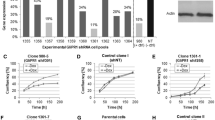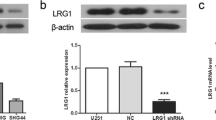Summary
To construct a lentiviral shRNA vector targeting human protein phosphatase 1D magnesium-dependent (PPM1D) gene and detect its effectiveness of gene silencing in human gliomas, specific siRNA targets with short hairpin frame were designed and synthesized. DNA oligo was cloned into the pFU-GW-iRNA lentiviral expression vector, and then PCR and sequencing analyses were conducted to verify the constructs. After the verified plasmids were transfected into 293T cells, the lentivirus was produced and the titer of virus was determined. Real-time quantitative PCR and Western blot were performed to detect the PPM1D expression level in the infected glioma cells. PCR and Western blot analyses revealed the optimal interfering target, and the virus with a titer of 6×108 TU/mL was successfully packaged. The PPM1D expression in human glioma cells was knocked down at both mRNA and protein levels by virus infection. The expression of PPM1D mRNA and protein was decreased by 76.3% and 87.0% respectively as compared with control group. The multiple functions of human glioma cells after PPM1D RNA interference were detected by flow cytometry and cell counting kit-8 (CCK-8). Efficient down-regulation of PPM1D resulted in significantly increased cell apoptosis and reduced cell proliferation and invasion potential in U87-MG cells. We have successfully constructed the lentiviral shRNA expression vector capable of stable PPM1D gene silencing at both mRNA and protein levels in glioma cells. And our data gave evidence that the reduced cell growth observed after PPM1D silencing in glioma cells was at least partly due to increased apoptotic cell death.
Similar content being viewed by others
References
Dehdashti AR, Hegi ME, Regli L, et al. New trends in the medical management of glioblastoma multiforme: the role of temozolomide chemotherapy. Neurosurg Focus, 2006,20(4):E6
Schwartzbaum JA, Fisher JL, Aldape KD, et al. Epidemiology and molecular pathology of glioma. Nat Clin Pract Neurol, 2006,2(9):494–503
Fiscella M, Zhang H, Fan S, et al. Wip1, a novel human protein phosphatase that is induced in response to ionizing radiation in a p53-dependent manner. Proc Natl Acad Sci USA, 1997,94(12):6048–6053
Choi J, Appella E, Donehower LA. The structure and expression of the murine wildtype p53-induced phosphatase 1 (Wip1) gene. Genomics, 2000,64(3):298–306
Li J, Yang Y, Peng Y, et al. Oncogenic properties of PPM1D located within a breast cancer amplification epicenter at 17q23. Nat Genet, 2002,31(2):133–134
Gorgoulis VG, Vassiliou LV, Karakaidos P, et al. Activation of the DNA damage checkpoint and genomic instability in human precancerous lesions. Nature, 2005, 434(7035):907–913
Bulavin DV, Demidov ON, Saito S, et al. Amplification of PPM1D in human tumors abrogates p53 tumor-suppressor activity. Nat Genet, 2002,31(2):210–215
Taylor WR, Stark GR. Regulation of the G2/M transition by p53. Oncogene, 2001,20(15):1803–1815
Saito-Ohara F, Imoto I, Inoue J, et al. PPM1D is a potential target for 17q gain in neuroblastoma. Cancer Res, 2003,63(8):1876–1883
Hirasawa A, Saito-Ohara F, Inoue J, et al. Association of 17q21-q24 gain in ovarian clear cell adenocarcinomas with poor prognosis and identification of PPM1D and APPBP2 as likely amplification targets. Clin Cancer Res, 2003,9(6):1995–2004
Castellino RC, De Bortoli M, Lu X, et al. Medulloblastomas overexpress the p53-inactivating oncogene WIP1/PPM1D. J Neurooncol, 2008,86(3):245–256
Lu X, Ma O, Nguyen TA, et al. The Wip1 Phosphatase acts as a gatekeeper in the p53-Mdm2 autoregulatory loop. Cancer Cell, 2007,12(4):342–354
Lu X, Nguyen TA, Zhang X, et al. The Wip1 phosphatase and Mdm2: cracking the “Wip” on p53 stability. Cell Cycle, 2008,7(2):164–168
Rodriguez M, Aladowicz E, Lanfrancone L, et al. Tbx3 represses E-cadherin expression and enhances melanoma invasiveness. Cancer Res, 2008,68(19):7872–7881
Lu X, Nguyen TA, Moon SH, et al. The type 2C phosphatase Wip1: an oncogenic regulator of tumor suppressor and DNA damage response pathways. Cancer Metastasis Rev, 2008,27(2):123–135
Choi J, Nannenga B, Demidov ON, et al. Mice deficient for the wild-type p53-induced phosphatase gene (Wip1) exhibit defects in reproductive organs, immune function, and cell cycle control. Mol Cell Biol, 2002,22(4):1094–1105
Gartel AL, Kandel ES. RNA interference in cancer. Biomol Eng, 2006,23(1):17–34
Wang X, Tang R, Xue Z, et al. Lentivector-mediated RNAi efficiently downregulates expression of murine TNF-alpha gene in vitro and in vivo. J Huazhong Univ Sci Technolog [Med Sci], 2009,29(1):112–117
Cenciarelli C, Budoni M, Mercanti D, et al. In vitro analysis of mouse neural stem cells genetically modified to stably express human NGF by a novel multigenic viral expression system. Neurol Res, 2006,28(5):505–512
Meunier A, Latremoliere A, Dominguez E, et al. Lentiviral-mediated targeted NF-kappaB blockade in dorsal spinal cord glia attenuates sciatic nerve injury-induced neuropathic pain in the rat. Mol Ther, 2007,15(4):687–697
Parssinen J, Alarmo EL, Khan S, et al. Identification of differentially expressed genes after PPM1D silencing in breast cancer. Cancer Lett, 2008,259(1):61–70
Macurek L, Lindqvist A, Voets O, et al. Wip1 phosphatase is associated with chromatin and dephosphorylates gammaH2AX to promote checkpoint inhibition. Oncogene, 2010,29(15):2281–2291
Zhang X, Lin L, Guo H, et al. Phosphorylation and degradation of MdmX is inhibited by Wip1 phosphatase in the DNA damage response. Cancer Res, 2009,69(20):7960–7968
Loukopoulos P, Shibata T, Katoh H, et al. Genome-wide array-based comparative genomic hybridization analysis of pancreatic adenocarcinoma: identification of genetic indicators that predict patient outcome. Cancer Sci, 2007,98(3):392–400
Demidov ON, Kek C, Shreeram S, et al. The role of the MKK6/p38 MAPK pathway in Wip1-dependent regulation of ErbB2-driven mammary gland tumorigenesis. Oncogene, 2007,26(17):2502–2506
Author information
Authors and Affiliations
Corresponding author
Additional information
This project was supported by a grant from National Natural Sciences Foundation of China (No. 30772240).
Rights and permissions
About this article
Cite this article
Wang, P., Rao, J., Yang, H. et al. PPM1D silencing by lentiviral-mediated RNA interference inhibits proliferation and invasion of human glioma cells. J. Huazhong Univ. Sci. Technol. [Med. Sci.] 31, 94–99 (2011). https://doi.org/10.1007/s11596-011-0157-1
Received:
Published:
Issue Date:
DOI: https://doi.org/10.1007/s11596-011-0157-1




